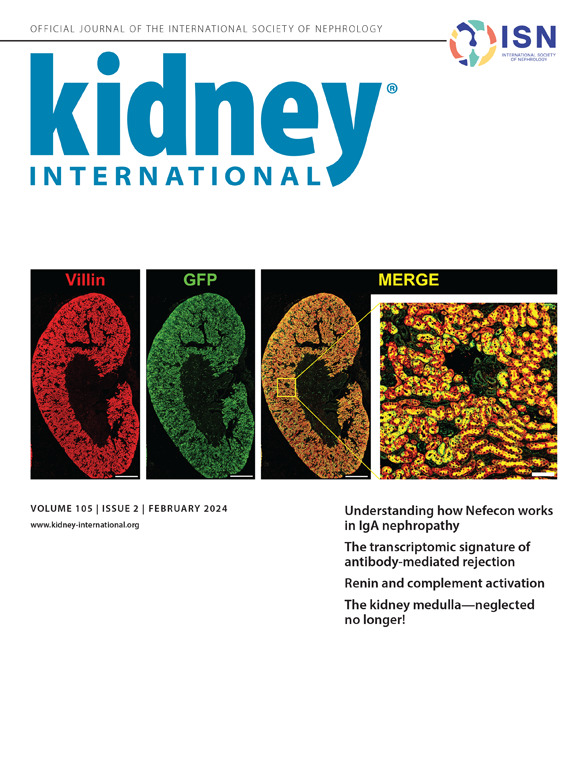Genetic screens of imaging-derived kidney volumes identify genes linked to kidney function.
IF 12.6
1区 医学
Q1 UROLOGY & NEPHROLOGY
引用次数: 0
Abstract
INTRODUCTION Chronic kidney disease (CKD) is defined as sustained abnormalities in kidney function or structure. Genetic studies of CKD have largely focused on kidney function markers such as estimated glomerular filtration rate (eGFR). We hypothesized that genome-wide association studies (GWAS) of magnetic resonance imaging (MRI)-based kidney sub-volumes could provide insights into CKD risk genes complementary to the study of eGFR. METHODS Total kidney volume (TKV) and sub-volumes for cortex, medulla, and sinus were derived from abdominal MRIs of 38,816 United Kingdom Biobank participants of European ancestry using a trained convolutional neural network. GWAS was performed for body surface area-normalized kidney volumes and eGFR for comparison. Potentially causal genes at each locus were prioritized using a developed annotation pipeline. We assessed locus overlap between volumes, biomarker-based kidney function, and clinical traits using colocalization analyses. Annotated genes were further characterized through enrichment analyses, molecular and clinical annotations, including a screen for rare, putative loss-of-function variants. RESULTS GWAS for 9,803,932 common genetic variants identified 34 significant loci for TKV, 24 for medulla, 26 for cortex, and 71 for sinus, compared to 32 for eGFR. Prioritized genes for cortex and medulla volumes showed corresponding tissue-specific expression and were enriched for kidney development- and hypoxia-related pathways. Genetic effect sizes of significant index single nucleotide polymorphisms for TKV, cortex, and medulla volumes correlated positively with those for eGFR. Some loci such as PKHD1 and BICC1 were strongly associated with kidney volumes but not eGFR. Integration with disease information revealed that rare, putative loss-of-function variants in BICC1, and common variants with regulatory potential, are associated with increased risk for CKD and dialysis, which was not identified in a previous GWAS of eGFR CONCLUSIONS: Our investigation shows that genetic findings of kidney structure can complement kidney function studies and reveal previously unrecognized CKD risk genes in the population.成像衍生肾体积的遗传筛选识别与肾功能相关的基因。
慢性肾脏疾病(CKD)被定义为肾脏功能或结构的持续异常。CKD的遗传学研究主要集中在肾功能标志物上,如肾小球滤过率(eGFR)的估计。我们假设基于磁共振成像(MRI)的肾亚体积全基因组关联研究(GWAS)可以为研究eGFR提供CKD风险基因的补充。方法使用训练好的卷积神经网络,从38,816名英国生物银行欧洲血统参与者的腹部mri中获得肾皮质、髓质和窦的总肾体积(TKV)和亚体积。对体表面积、肾体积和eGFR进行GWAS比较。利用开发的注释管道对每个位点上的潜在致病基因进行了优先排序。我们使用共定位分析评估了基因座在体积、基于生物标志物的肾功能和临床特征之间的重叠。通过富集分析、分子和临床注释,包括筛选罕见的、假定的功能丧失变异,对注释基因进行进一步表征。结果9803932个常见遗传变异的gwas鉴定出34个TKV显著位点,24个髓质显著位点,26个皮质显著位点,71个鼻窦显著位点,而eGFR为32个。皮层和髓质体积的优先基因显示出相应的组织特异性表达,并在肾脏发育和缺氧相关途径中富集。TKV、皮质和髓质体积显著指数单核苷酸多态性的遗传效应大小与eGFR的遗传效应大小呈正相关。一些位点如PKHD1和BICC1与肾体积密切相关,但与eGFR无关。与疾病信息的整合显示,BICC1中罕见的、推测的功能丧失变异,以及具有调节潜力的常见变异,与CKD和透析风险增加相关,这在之前的eGFR GWAS中未被发现。结论:我们的研究表明,肾脏结构的遗传发现可以补充肾功能研究,揭示人群中以前未被识别的CKD风险基因。
本文章由计算机程序翻译,如有差异,请以英文原文为准。
求助全文
约1分钟内获得全文
求助全文
来源期刊

Kidney international
医学-泌尿学与肾脏学
CiteScore
23.30
自引率
3.10%
发文量
490
审稿时长
3-6 weeks
期刊介绍:
Kidney International (KI), the official journal of the International Society of Nephrology, is led by Dr. Pierre Ronco (Paris, France) and stands as one of nephrology's most cited and esteemed publications worldwide.
KI provides exceptional benefits for both readers and authors, featuring highly cited original articles, focused reviews, cutting-edge imaging techniques, and lively discussions on controversial topics.
The journal is dedicated to kidney research, serving researchers, clinical investigators, and practicing nephrologists.
 求助内容:
求助内容: 应助结果提醒方式:
应助结果提醒方式:


